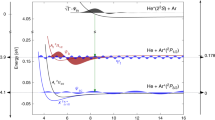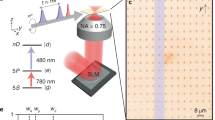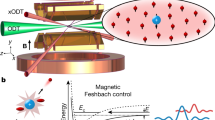Abstract
Atoms with a highly excited electron, called Rydberg atoms, can form unusual types of molecular bonds1,2,3,4. The bonds differ from the well-known ionic and covalent bonds5,6 not only by their binding mechanisms, but also by their bond lengths ranging up to several micrometres. Here we observe a new type of molecular ion based on the interaction between the ionic charge and a flipping-induced dipole of a Rydberg atom with a bond length of several micrometres. We measure the vibrational spectrum and spatially resolve the bond length and the angular alignment of the molecule using a high-resolution ion microscope7. As a consequence of the large bond length, the molecular dynamics is extremely slow. These results pave the way for future studies of spatio-temporal effects in molecular dynamics (for example, beyond Born–Oppenheimer physics).
This is a preview of subscription content, access via your institution
Access options
Access Nature and 54 other Nature Portfolio journals
Get Nature+, our best-value online-access subscription
$29.99 / 30 days
cancel any time
Subscribe to this journal
Receive 51 print issues and online access
$199.00 per year
only $3.90 per issue
Buy this article
- Purchase on Springer Link
- Instant access to full article PDF
Prices may be subject to local taxes which are calculated during checkout




Similar content being viewed by others
Data availability
The experimental and theoretical data that support the findings of this study are available from the corresponding author upon request. Source data are provided with this paper.
Code availability
The experimental data were analysed using Matlab and a self-written analysis script. The molecular potentials were calculated using the pairinteraction program38 and Python. Matlab and self-written scripts were used to calculate the angular-dependent excitation probability. The simulation results can be generated using the numerical methods described in the Methods and the computer code developed, which are available upon request.
References
Greene, C. H., Dickinson, A. S. & Sadeghpour, H. R. Creation of polar and nonpolar ultra-long-range Rydberg molecules. Phys. Rev. Lett. 85, 2458–2461 (2000).
Boisseau, C., Simbotin, I. & Côté, R. Macrodimers: ultralong range Rydberg molecules. Phys. Rev. Lett. 88, 133004 (2002).
Bendkowsky, V. et al. Observation of ultralong-range Rydberg molecules. Nature 458, 1005–1008 (2009).
Overstreet, K. R., Schwettmann, A., Tallant, J., Booth, D. & Shaffer, J. P. Observation of electric-field-induced Cs Rydberg atom macrodimers. Nat. Phys. 5, 581–585 (2009).
Bransden, B. H. & Joachain, C. J. Physics of Atoms and Molecules (Longman, 1986).
Gray, H. B. Chemical Bonds: an Introduction to Atomic and Molecular Structure (University Science Books, 1994).
Veit, C. et al. Pulsed ion microscope to probe quantum gases. Phys. Rev. 11, 011036 (2021).
Köhler, T., Góral, K. & Julienne, P. S. Production of cold molecules via magnetically tunable Feshbach resonances. Rev. Mod. Phys. 78, 1311–1361 (2006).
Greene, C. H., Giannakeas, P. & Pérez-Ríos, J. Universal few-body physics and cluster formation. Rev. Mod. Phys. 89, 035006 (2017).
Nichols, M. A. et al. Detection of long-lived complexes in ultracold atom-molecule collisions. Phys. Rev. X 12, 011049 (2022).
Mayle, M., Quéméner, G., Ruzic, B. P. & Bohn, J. L. Scattering of ultracold molecules in the highly resonant regime. Phys. Rev. A 87, 012709 (2013).
Shaffer, J. P., Rittenhouse, S. T. & Sadeghpour, H. R. Ultracold Rydberg molecules. Nat. Commun. 9, 1965 (2018).
Fey, C., Hummel, F. & Schmelcher, P. Ultralong-range Rydberg molecules. Mol. Phys. 118, e1679401 (2020).
Lukin, M. D. et al. Dipole blockade and quantum information processing in mesoscopic atomic ensembles. Phys. Rev. Lett. 87, 037901 (2001).
Urban, E. et al. Observation of Rydberg blockade between two atoms. Nat. Phys. 5, 110–114 (2009).
Schwarzkopf, A., Anderson, D. A., Thaicharoen, N. & Raithel, G. Spatial correlations between Rydberg atoms in an optical dipole trap. Phys. Rev. A 88, 061406 (2013).
Schwarzkopf, A., Sapiro, R. E. & Raithel, G. Imaging spatial correlations of Rydberg excitations in cold atom clouds. Phys. Rev. Lett. 107, 103001 (2011).
Schauß, P. et al. Observation of spatially ordered structures in a two-dimensional Rydberg gas. Nature 491, 87–91 (2012).
Browaeys, A. & Lahaye, T. Many-body physics with individually controlled Rydberg atoms. Nat. Phys. 16, 132–142 (2020).
Hollerith, S. et al. Quantum gas microscopy of Rydberg macrodimers. Science 364, 664–667 (2019).
Hollerith, S. et al. Microscopic electronic structure tomography of Rydberg macrodimers. Phys. Rev. Res. 3, 013252 (2021).
Härter, A. & Hecker Denschlag, J. Cold atom–ion experiments in hybrid traps. Contemp. Phys. 55, 33–45 (2014).
Kleinbach, K. S. et al. Ionic impurity in a Bose-Einstein condensate at submicrokelvin temperatures. Phys. Rev. Lett. 120, 193401 (2018).
Tomza, M. et al. Cold hybrid ion-atom systems. Rev. Mod. Phys. 91, 035001 (2019).
Ewald, N. V., Feldker, T., Hirzler, H., Fürst, H. A. & Gerritsma, R. Observation of interactions between trapped ions and ultracold Rydberg atoms. Phys. Rev. Lett. 122, 253401 (2019).
Dieterle, T. et al. Inelastic collision dynamics of a single cold ion immersed in a Bose-Einstein condensate. Phys. Rev. A 102, 041301 (2020).
Schmidt, J., Weckesser, P., Thielemann, F., Schaetz, T. & Karpa, L. Optical traps for sympathetic cooling of ions with ultracold neutral atoms. Phys. Rev. Lett. 124, 053402 (2020).
Dieterle, T. et al. Transport of a single cold ion immersed in a Bose-Einstein condensate. Phys. Rev. Lett. 126, 033401 (2021).
Weckesser, P. et al. Observation of Feshbach resonances between a single ion and ultracold atoms. Nature 600, 429–433 (2021).
Duspayev, A. et al. Long-range Rydberg-atom–ion molecules of Rb and Cs. Phys. Rev. Res. 3, 023114 (2021).
Deiß, M., Haze, S. & Hecker Denschlag, J. Long-range atom–ion Rydberg molecule: a novel molecular binding mechanism. Atoms 9, 34 (2021).
Mukherjee, R. Charge dynamics of a molecular ion immersed in a Rydberg-dressed atomic lattice gas. Phys. Rev. A 100, 013403 (2019).
Price, T. J. & Greene, C. H. Semiclassical treatment of high-lying electronic states of H2+. J. Phys. Chem. A 122, 8565–8575 (2018).
Duspayev, A. & Raithel, G. Nonadiabatic decay of Rydberg-atom–ion molecules. Phys. Rev. A 105, 012810 (2022).
Bonin, K. D. & McIlrath, T. J. Two-photon electric-dipole selection rules. J. Opt. Soc. Am B 1, 52–55 (1984).
SIMION v8.1.1.32 (Scientific Instrument Services, 2013).
Jackson, J. D. Classical Electrodynamics 3rd edn (Wiley, 1999).
Weber, S. et al. Calculation of Rydberg interaction potentials. J. Phys. B 50, 133001 (2017).
Shore, B. W. The Theory of Coherent Atomic Excitation (Wiley, 1990).
Acknowledgements
We thank T. Schmid and C. Veit for their work and support in building the ion microscope. Further, we thank O. A. Herrera-Sancho for support during the calibration of the microscope and S. Weber for help with the pairinteraction code. We are indebted to the mechanics and electronics workshop for manufacturing the ion microscope and the high-voltage power supplies. This work was supported by the Deutsche Forschungsgemeinschaft (DFG; project numbers Pf 381/17-1 and Pf 381/17-2) as part of the SPP 1929 “Giant Interactions in Rydberg Systems (GiRyd)” and has received funding from the QuantERA ERANET programme under the project “Theory-Blind Quantum Control—TheBlinQC’’ (grant no. 13N14847). The project received funding from the European Research Council under the European Union’s Horizon 2020 research and innovation programme (grant agreement number 101019739 - LongRangeFermi). F.M. acknowledges support from the Carl Zeiss Foundation through IQST and is indebted to the Baden-Württemberg-Stiftung for the financial support by the Eliteprogramm for Postdocs.
Author information
Authors and Affiliations
Contributions
The experiments were carried out by N.Z., V.S.V.A., M.B. and Y.-Q.Z.; data analysis was performed by N.Z. and Y.-Q.Z.; the presented simulations and theoretical calculations were conducted by N.Z. and Y.-Q.Z.; project guidance was provided by F.M., R.L. and T.P.; the manuscript was written by N.Z. with contributions from all authors.
Corresponding author
Ethics declarations
Competing interests
The authors declare no competing interests.
Peer review
Peer review information
Nature thanks Michal Tomza and the other, anonymous, reviewer(s) for their contribution to the peer review of this work. Peer reviewer reports are available.
Additional information
Publisher’s note Springer Nature remains neutral with regard to jurisdictional claims in published maps and institutional affiliations.
Extended data figures and tables
Extended Data Fig. 1 Potential energy curves with bound vibrational states and measured spectrum.
a, Potential energy curves corresponding to the 69P-state with \(|{m}_{J}|=1/2\). b, Magnified view of the region marked with a grey box in a with the two potential curves containing the vibrational bound states. Grey lines indicate the energy of vibrational states with vibrational wave functions plotted in blue. c, Normalised molecular signal as a function of the Rydberg laser detuning Δ. Error bars denote standard error of the mean.
Extended Data Fig. 2 Lifetime measurement with in situ images.
Molecular signal strength measured for different wait times t between the molecule creation and imaging. The exponential fit (blue line) results in a 1/e lifetime of 2.6 μs ± 0.2 μs for the lowest vibrational state in the molecular potential corresponding to the |69P1/2⟩-state. The insets show two in situ images for 0.7 μs and 3.5 μs wait time. Error bars denote one standard deviation.
Extended Data Fig. 3 Admixture of Ryberg states.
Contributions \(|{c}_{l}|\) of states mixed into the electronic molecular state below the |69P1/2⟩ asymptote. Here only those states are shown which can be excited with the two-photon scheme from the ground state \(|g\rangle \). In calculation of the two-photon excitation probability the electronic molecular state is truncated after the first six states with the largest contribution (coloured). The nuclear radial probability density (light grey) indicates the extend of the lowest vibrational state ν = 0.
Supplementary information
Rights and permissions
About this article
Cite this article
Zuber, N., Anasuri, V.S.V., Berngruber, M. et al. Observation of a molecular bond between ions and Rydberg atoms. Nature 605, 453–456 (2022). https://doi.org/10.1038/s41586-022-04577-5
Received:
Accepted:
Published:
Issue Date:
DOI: https://doi.org/10.1038/s41586-022-04577-5
This article is cited by
-
Field-linked resonances of polar molecules
Nature (2023)
Comments
By submitting a comment you agree to abide by our Terms and Community Guidelines. If you find something abusive or that does not comply with our terms or guidelines please flag it as inappropriate.



